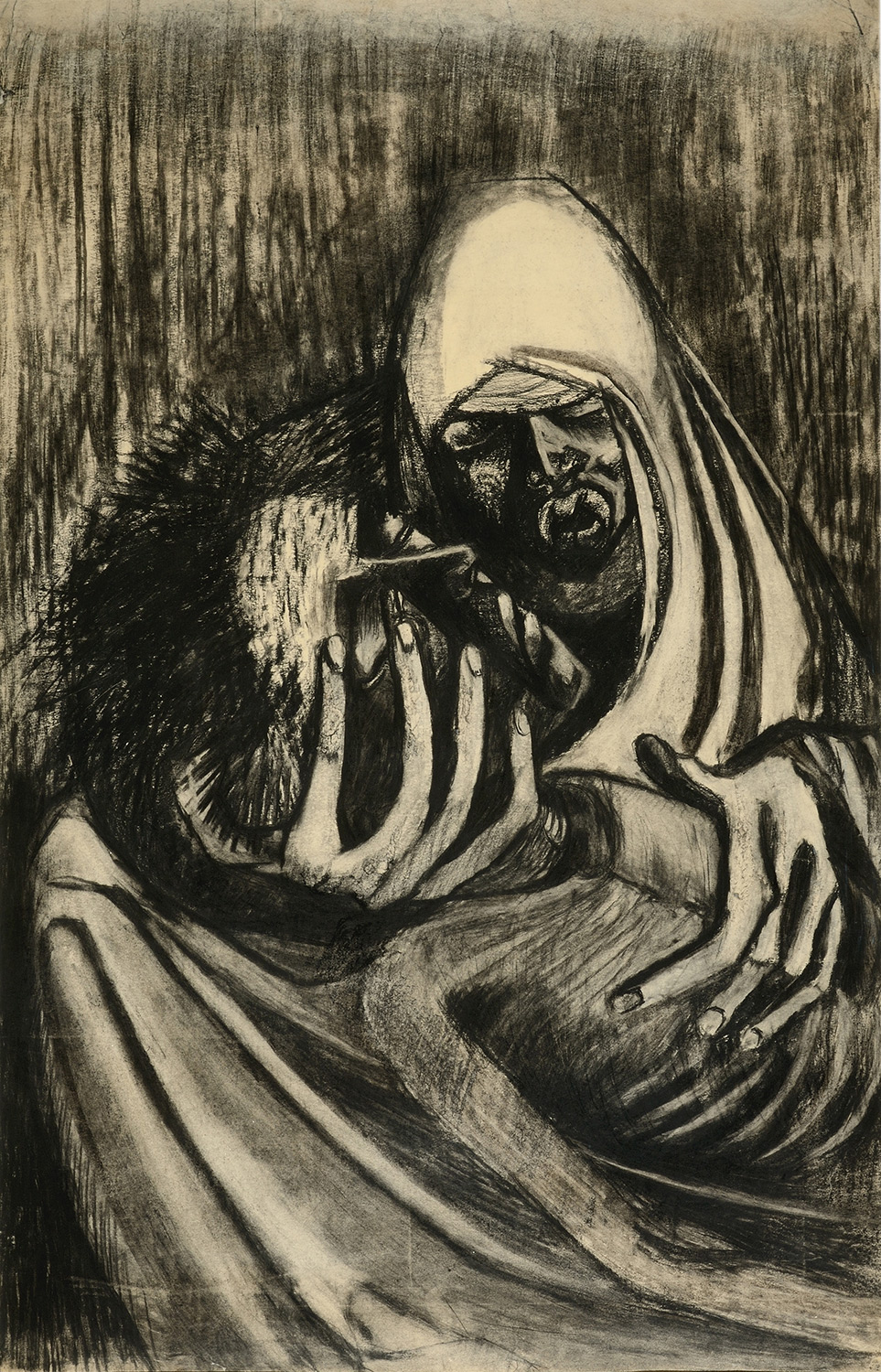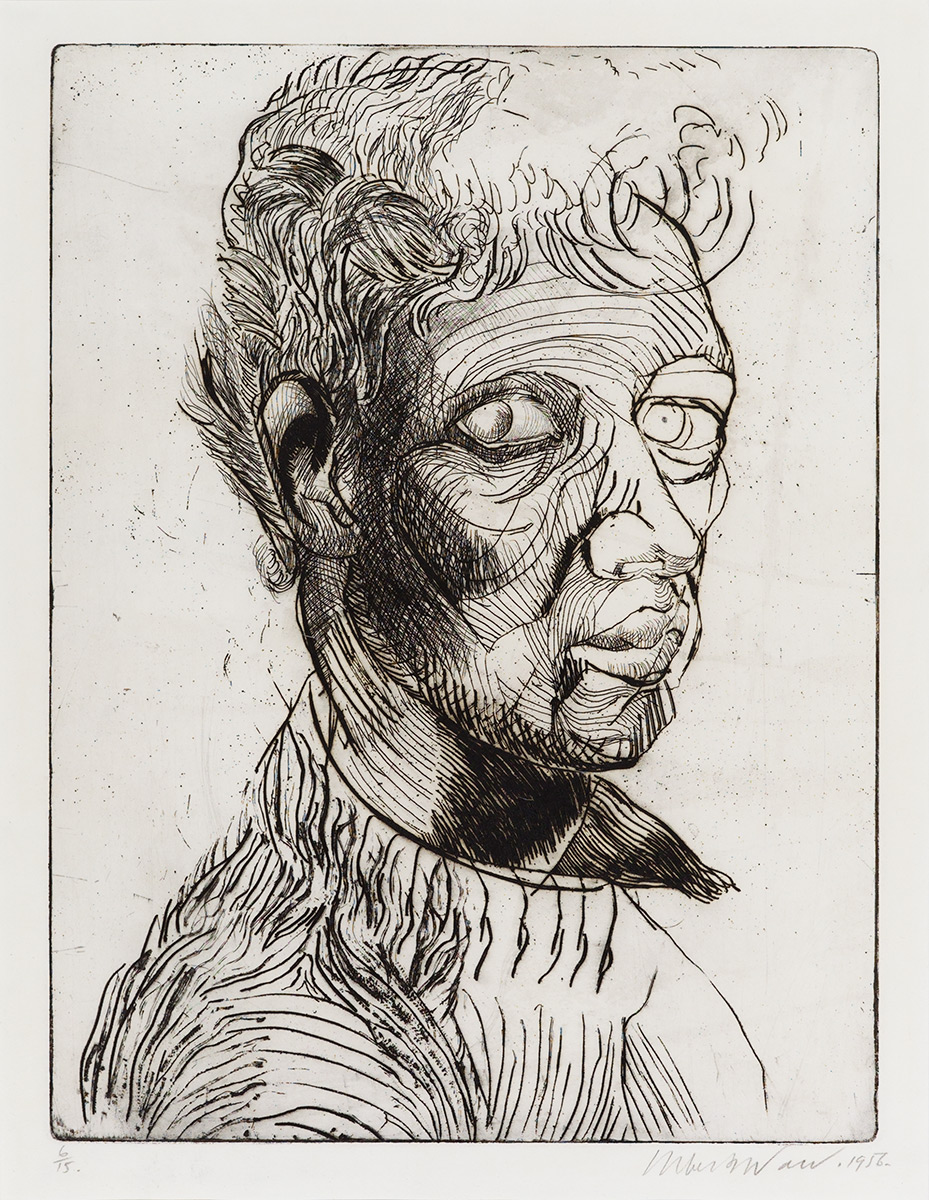ALBERT ADAMS (1929 – 2006)
Pieta
1948
charcoal on paper
99 x 68.5 cm
In this wretchedly expressionistic version of the Pietà, Albert Adams depicts a mother cradling a gaunt and emaciated grown son in her arms. The wrenching work conveys the painful sense of an adult psyche that remains haunted by childhood agonies. Adams’s early life experiences as a deeply marginalised citizen in apartheid South Africa never left him. This work also brings to mind Adams’s reflections on his own childhood:
I was born in 1930 in Johannesburg. At the age of four I travelled with my mother and sister, a baboon soft-toy and my comfort blanket to Cape Town. I had to live with my grandmother because my mother had obtained employment as a living-in domestic. I never knew my father. I was amazed to see how many children lived in my grandmother’s house. Sometimes I sneaked away to sleep where my mother was employed I had to be quiet as I arrived when they had their evening meal, and be gone in the morning before the household awoke. This has had a great in influence on my life. I found myself constantly alone in my mother’s outside-room, the feeling of confused abandonment. I had to amuse myself, and happened to find a pencil.
In 2006, he declared:
My work is based on my experience of South Africa as a ‘vast and terrifying prison’ – an experience which even now, after a decade of democracy, still… Continue reading
Self Portrait
1956
etching
38 x 50 cm
edition 6/15
Exploring the personal as well as the political, Adams produced a lifelong series of self-portraits, considering his own African-Indian heritage and identity.
As writer, curator and creative producer Greg Thorpe writes:
Adams created numerous self-portraits over many years, often producing images and versions of his face that are unrecognisable from era to era. It’s tempting to consider the self-portraits as emerging from two artistic intents – a changing vision of himself as an individual that he desired to reckon with aesthetically, politically, and perhaps also spiritually; and as a means to explore new artistic techniques on a subject that was known and within his grasp. The truth is likely some kind of synthesis of the two, and consequently what they produce over time is a record of both skill and self-interpretation.
This early work from 1956 is touchingly youthful and probably one of his earliest etchings. At the Slade, Adams had been taught by the influential printmaker Anthony Gross and this work demonstrates Adams’s experimentation with etching techniques.
SOURCE
Greg Thorpe, ‘Albert Adams: Finding His Time,’ The Fourdrinier, https://www.thefourdrinier.com/albert-adams-finding-his-time.
‘Albert Adams: In Context,’ Art UK, https://artuk.org/discover/curations/albert-adams-in-context/template/storyline.
BIOGRAPHY
Albert Adams was born in Johannesburg on 23 June 1929. His Hindu father had emigrated from India to South Africa in 1911. His mother, Emma Caroline, was a Coloured South African who made a living as a domestic worker. At the age of four, after his parents separated, Adams moved to Cape Town with his mother and sister.
While living in Cape Town, Adams attended Arsenal Road Primary School, and later the Livingstone High School in Claremont. It was here that his teachers noticed his talent for drawing. Adams’s time at Livingstone was a defining period in his life, as he came under the influence of some of the teaching staff who were leading coloured intellectuals at the time, and prominent members of the Non-European Unity Movement. Adams excelled at school, edited the school magazine and became Head Boy.
At Livingstone, he also befriended fellow student Peter Clarke, who was from a poor working-class background and would later become one of the leading artists and poets in the country. Adams and Clarke were to become life-long friends.
After completing his Matric, the highly political young Adams applied to study at the University of Cape Town’s Michaelis School of Fine Arts, but due to the university’s racial discriminatory policy he was turned down. In order to gather funds to continue his studies, he found work as a window dresser.
In the late 1940s, he began attending art classes at St Peters school in District Six, which was founded by David Copeland. Adams invited his friend Peter Clarke to join the classes, and the pair became an integral part of the vibrant political and cultural scene in Cape Town.
Adams then enrolled for a teaching degree at Hewat Teacher Training College where he became head of the National Union of South African Students. Soon, Adams became actively involved in the anti-apartheid movement. After being arrested twice, Adams realised that the South African political situation was rapidly deteriorating, and applied to universities in England, including Durham, Oxford and London. He was accepted to all of these institutions, but was advised by Oxford to attend the Slade School of Art in London.
Adams moved to London with the help from his two German friends and supporters, Baron Rudolf von Freiling and Siegfried Eick. He studied in London from 1953 to 1957, when he was awarded a scholarship to the Munich School of Art. He remained in Europe for the next two years, first in Munich and then in Salzburg where he studied under expressionist artist Oskar Kokoschka. Adams and Kokoschka became close friends.
Adams returned to Cape Town in the late 1950s and held his first solo exhibition at the Argus gallery in 1959. One of the most groundbreaking works he produced around this time was the ‘South Africa 1959’ triptych. The work anticipates an apocalypse of apartheid that would traumatise the country for another 35 years, and is now part of the Johannesburg Art Gallery.
After the Sharpeville Massacre in 1960, Adams and many other South Africans left the country to settle in London. In the UK, he taught at a number of high schools, and in 1979 began teaching Art History at City College in London. He held this post for the next 18 years.
When liberation movements were unbanned in 1990, Adams made regular trips to South Africa to visit his family, and participated in artists’ workshops. Towards the end of 2006 he was diagnosed with lung cancer and passed away on 31st December 2006. He donated his works to the Iziko South African National Gallery, and a retrospective of his work was opened at the gallery on 19 July 2008.



